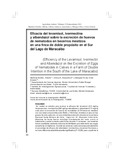Mostrar el registro sencillo del ítem
Eficacia del levamisol, ivermectina y albendazol sobre la excreción de huevos de nematodos en becerros mestizos en una finca de doble propósito en el Sur del Lago de Maracaibo
| dc.rights.license | http://creativecommons.org/licenses/by-nc-sa/3.0/ve/ | |
| dc.contributor.author | Martínez Guillén, Alberto | |
| dc.contributor.author | Urbina, Anacelmira | |
| dc.contributor.author | Márquez Pérez, Víctor E. | |
| dc.date.accessioned | 2014-11-06T21:18:36Z | |
| dc.date.available | 2014-11-06T21:18:36Z | |
| dc.date.issued | 2011-01-01T21:18:36Z | |
| dc.identifier.issn | 1315-3919 | |
| dc.identifier.uri | http://www.saber.ula.ve/handle/123456789/39295 | |
| dc.description.abstract | Se realizó un estudio para evaluar la eficacia del levamisol (3,5 mg/Kg intramuscular), ivermectina (200 μg/Kg subcutánea) y albendazol (7,5 mg/Kg oral) sobre la excreción de huevos de nemátodos en 24 becerros mestizos con una edad comprendida entre 59,82 y 119,6 días, divididos al azar en tres grupos de ocho cada uno, en una unidad de producción ubicada en la carretera Nacional Santa Bárbara del Zulia - Vigía, km. 41, Municipio Colón-Zulia. Muestras de heces fueron extraídas directamente del recto, previo al tratamiento y posteriormente cada 8 días durante 11 semanas. Las muestras fueron analizadas mediante la técnica de McMaster para determinar las cargas parasitarias en h/g/heces. Durante las primeras cuatro semanas postratamiento el porcentaje de eficacia del albendazol, ivermectina y levamisol fue bueno y no hubo diferencia estadísticamente significativa (P > 0,05), pero a partir de la cuarta semana comienza a disminuir paulatinamente y la persistencia de la eficacia es mantenida por la ivermectina seguido del albendazol, sin embargo el levamisol es el que exhibe una menor persistencia desde la cuarta a la onceava semana, observándose una eficacia del 78,352 %; 49,376 %; y - 154,453 % respectivamente, para la décima semana luego de administrado el tratamiento. Esto puede ser debido a que la ivermectina y el albendazol tuvieron efecto adulticida, ovicida y larvicida, mientras que el levamisol no fue tan eficiente como larvicida y por lo tanto un mayor número de L4 sobrevivientes pudieron pasar a su estadio de adultos y comenzaron a poner huevos en mayor cantidad que en los becerros tratados con ivermectina y albendazol. | es_VE |
| dc.language.iso | es | es_VE |
| dc.rights | info:eu-repo/semantics/openAccess | |
| dc.subject | Antihelmínticos | es_VE |
| dc.subject | Becerros | es_VE |
| dc.subject | Nemátodos | es_VE |
| dc.title | Eficacia del levamisol, ivermectina y albendazol sobre la excreción de huevos de nematodos en becerros mestizos en una finca de doble propósito en el Sur del Lago de Maracaibo | es_VE |
| dc.title.alternative | Efficiency of the levamisol, ivermectin and albendazol on the excretion of eggs of nematodes in calves in a farm of double intention in the South of the Lake of Maracaibo | es_VE |
| dc.type | info:eu-repo/semantics/article | |
| dc.description.abstract1 | A study was conducted to evaluate the efficacy of levamisole (3.5 mg / kg intramuscular), ivermectin (200 micrograms / kg subcutaneous) and albendazole (7.5 mg / kg orally) on the excretion of nematode eggs in 24 crossbred with an age between 59.82 and 119.6 days, divided randomly into three groups of eight each, in a production unit located in the National Road Santa Barbara of Zulia - Vigía, km 41, Colón-Zulia Municipality. Stool samples were extracted directly from the rectum before treatment and then every 8 days for 11 weeks. Samples were analyzed using the McMaster technique to determine the parasite loads in hpg During the first four weeks after treatment the percentage of efficacy of albendazole, ivermectin and levamisole was good and there was no statistically significant difference (P> 0.05), but from the fourth week begins to decrease gradually and the persistence of efficacy is maintained by albendazole followed ivermectin, levamisole is yet which exhibits a reduced persistence from the fourth to the eleventh week, observed an efficiency of 78.352%, 49.376%, and -154.453% respectively for the tenth week after administered treatment. This may be due to ivermectin and albendazole had adulticide effect, ovicidal and larvicidal, while levamisole was not as efficient as a larvicide and therefore a greater number of surviving L4 could happen to their adult stage and began to put eggs in greater numbers than in calves treated with ivermectin and albendazole. | es_VE |
| dc.description.colacion | 30-42 | es_VE |
| dc.description.email | albertomart@ula.ve | es_VE |
| dc.description.email | anacelmira@ula.ve | es_VE |
| dc.description.frecuencia | semestral | |
| dc.identifier.depositolegal | 82-0231 | |
| dc.subject.facultad | Facultad de Ciencias Forestales y Ambientales | es_VE |
| dc.subject.institutoinvestigacion | Instituto de Investigaciones Agropecuarias | |
| dc.subject.keywords | Anthelmintics | es_VE |
| dc.subject.keywords | Yearling calves | es_VE |
| dc.subject.keywords | Nematodes | es_VE |
| dc.subject.publicacionelectronica | Revista Agricultura Andina | |
| dc.subject.seccion | Revista Agricultura Andina: Artículos | es_VE |
| dc.subject.thematiccategory | Medio Ambiente | es_VE |
| dc.subject.tipo | Revistas | es_VE |
| dc.type.media | Texto | es_VE |
Ficheros en el ítem
Este ítem aparece en la(s) siguiente(s) colección(ones)
-
Revista Agricultura Andina - Vol. 019
Extraordinario 2011


